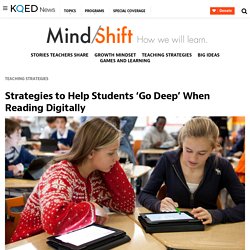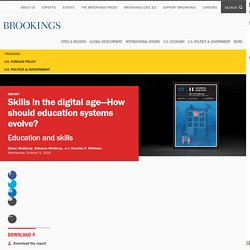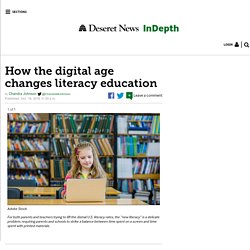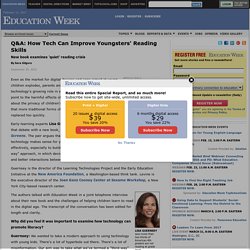

Strategies to Help Students ‘Go Deep’ When Reading Digitally. Students are doing more reading on digital devices than they ever have before.

Not only are many teachers using tablets and computers for classroom instruction, but many state tests are now administered on computers, adding incentive for teachers to teach digital reading strategies. But casual digital reading on the internet has instilled bad habits in many students, making it difficult for them to engage deeply with digital text in the same way they do when reading materials printed on paper.
Devin Hess sympathizes with educators’ concerns, but believes digital reading is here to stay and teachers have a duty to equip students to engage with digital texts in meaningful ways. Hess was a middle school social studies teacher and early tech adopter in his classroom. Now he works with the UC Berkeley History-Social Science Project training social studies teachers on deep reading strategies. “I don’t believe technology should ever be taught separately,” Hess said. Skills in the digital age—How should education systems evolve? 1.1 What’s the issue?

At no point in history have more children been enrolled in formal education. Thanks to global commitments and movements such as the Millennium Development Goals and Education For All, more than 90 percent of all primary-age children are now in school. But efforts to expand children’s education have served to obscure the surreptitious rise of a global learning crisis. An estimated 650 million children have not reached foundational developmental and learning milestones: 200 million under the age of five are not meeting basic socio-emotional and cognitive growth indicators; 250 million (half of whom are in school) lack basic literacy or math skills; and another 200 million youth do not possess the basic set of literacy and numeracy skills they will need for work.
Education and the acquisition of skills are crucial to solving some of the world’s most pressing problems. Get global education updates from Brookings 1.2 What’s the Debate? 1.3 What to watch out for? From Written to Digital: The New Literacy. Both the 21st-century economy and the careers needed to fuel it are changing at an unprecedented rate.

Students must be prepared for nonlinear careers, pivoting to match the ever-changing work landscape. We thus need to rethink not just how we teach our students but what we teach our students. The people who were comfortable at this humanities-technology intersection helped to create the human-machine symbiosis that is at the core of this story. In his book about the history of the digital revolution, Walter Isaacson contends that the major innovations of the digital revolution—from the first general-purpose computer to the transistor to the iPhone—were all created by individuals who understood how to synthesize the humanities with technology.
Yet even though there is much focus in higher education on how we teach using technology (e.g., e-texts, flipped classrooms, adaptive learning, personalized learning), what we teach about technology is just as important. How Should Reading Be Taught in a Digital Era? How the digital age changes literacy education. In most U.S. schools, it used to be that children were expected to arrive at kindergarten ready to read — mastering the alphabet and beginning to sound words out on their own.

But if a child arrives at school with just their ABCs and 123s, it might not be enough, says University of Nevada literacy professor Diane Barone. “It creates a double disadvantage for kids if the home doesn’t have a lot of books in it and they don’t have computers or internet access,” Barone said. “It’s hard if they don’t see a lot of technology before they come to school because other kids have seen it since they were 2 or 3.
Q&A: Researcher Identifies Gaps in Online-Reading Skills. Researcher Donald J.

Leu of the University of Connecticut talked with Education Week about his new study, “The New Literacies of Online Research and Comprehension: Rethinking the Reading Achievement Gap.” What do you want educators to understand about your new research? The biggest challenge I have when I try to explain the work that we do is that most people assume that offline and online reading are the same.
There is overlap. Sounding out words, vocabulary knowledge, those apply online or offline. But when it comes to trying to locate information [online], there are different tools and skills that are required. Donald J. Talking to principals and teachers, the classic example is the new assessments delivered by computer. Q&A: How Tech Can Improve Youngsters' Reading Skills.
By Sara Gilgore Even as the market for digital devices and apps aimed at young children explodes, parents and educators alike remain wary of technology's growing role in early-childhood education.

They point to the harmful effects of excessive screen time, worry about the privacy of children's sensitive information, and fear that more traditional forms of learning and play are being replaced too quickly. Early-learning experts Lisa Guernsey and Michael H. Levine last month waded into that debate with a new book, Tap, Click, Read: Growing Readers in a World of Screens. The pair argues that the current debate should focus less on whether technology makes sense for young children and more on how it can be used most effectively, especially to build fundamental literacy skills. Guernsey is the director of the Learning Technologies Project and the Early Education Initiative at the New America Foundation, a Washington-based think tank.
MICHAEL H. Vol. 35, Issue 06, Page 8. Q&A With David Denby: 'Serious' Reading in the Digital Age.